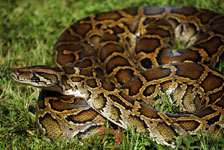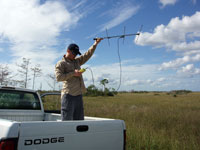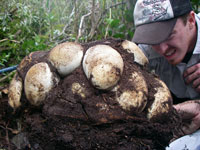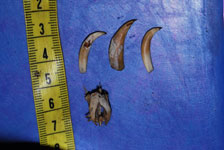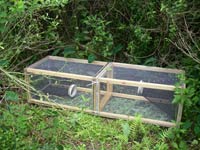Radiotelemetry and Control of Burmese Pythons
South Florida's subtropical environment is home to numerous reptile species that were brought here via the pet trade from their native habitats in Asia, Africa, and South America. As pets escape or are intentionally released, many of these nonnative species have established wild populations within urban and manmade habitats. But some, like the Burmese python (Python molurus bivittatus), have successfully invaded south Florida's natural areas. A large breeding population of Burmese pythons currently inhabits areas in and around Everglades National Park, and pythons have been found in other areas such as the Florida Keys. Burmese pythons are one of the largest snakes in the world (growing to 20 ft. or more in length), live a long time (15-25 years), and reproduce rapidly (up to 100 eggs per nest). They feed on a wide variety of native wildlife, including threatened and endangered species, and compete with native predators for food and habitat. In these ways Burmese pythons may seriously disrupt the ecology of south Florida.
The University of Florida research team is collaborating with the National Park Service, U.S. Geological Survey, U.S. Fish and Wildlife Service, South Florida Water Management District, and Davidson College to understand the extent of pythons' impact on Florida's ecosystems and develop methods to control the population. We are using radiotelemetry and other technology (GPS transmitters, accelerometers) to learn what habitats pythons use and how far they move, and to locate breeding groups. We are also analyzing what the snakes eat to determine what native species are most at risk. The information we gain about pythons' distribution, diet, movements, and habitat use is being applied to design the most effective plans for their control and removal.
Video
Images
Fact Sheets
The Invasion Curve: A Tool for Understanding Invasive Species Management in South Florida (PDF)
The Invasion of Exotic Reptiles and Amphibians in Florida (PDF)
Burmese Pythons in South Florida: Scientific Support for Invasive Species Management (English / Español)
Nonnative Reptiles in South Florida: Identification Guide
Select Publications
Mazzotti, F.J., M.S. Cherkiss, K.M. Hart, S. Snow, M.R. Rochford, M.E. Dorcas, and R. Reed. 2010. Cold-induced mortality of invasive Burmese pythons in south Florida. Biological Invasions 13(1):143-151.
Rochford, M., M.L. Brien, J. Carrigan, R.W. Snow, and F.J. Mazzotti. 2010. Python molurus bivittatus (Burmese python), clutch size. Herpetological Review 41(1):97.
Snow, R.W., A.J. Wolf, B.W. Greeves, M.S. Cherkiss, R. Hill, and F.J. Mazzotti. 2010. Thermoregulation by a brooding Burmese python (Python molurus bivittatus) in Florida. Southeastern Naturalist 9(2):403-405.
Krysko, K.L., J.C. Nifong, R.W. Snow, K.M. Enge, and F.J. Mazzotti. 2008. Reproduction of the Burmese python (Python molurus bivittatus) in southern Florida. Applied Herpetology 5(1):93-95.
Snow, R.W., V.M. Johnson, M.L. Brien, M.S. Cherkiss, and F.J. Mazzotti. 2007. Python molurus bivittatus: nesting. Herpetological Review 38(1):93.
Snow, R.W., M.L. Brien, M.S. Cherkiss, L. Wilkins, and F.J. Mazzotti. 2007. Dietary habits of Burmese python, Python molurus bivittatus, from Everglades National Park, Florida. British Herpetological Bulletin 101:5-7.
Links
PBS/Nature's "Invasion of the Giant Pythons"
National Geographic Explorer's "Python Wars"
Everglades National Park Burmese python information
Davidson College Burmese python research
Florida Fish and Wildlife Conservation Commission nonnative species
